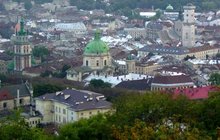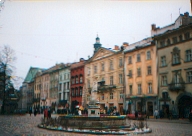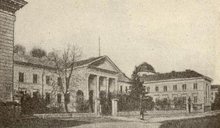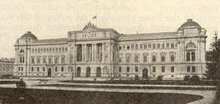Lviv
|
|
L'viv or Lviv (Template:Lang-ua; Polish: Missing image
Ltspkr.png
Image:Ltspkr.png
Lwów; German: Lemberg; Latin: Leopolis; Template:Lang-ru; see also cities' alternative names) is a city in western Ukraine with 830,000 inhabitants (an additional 200,000 commute daily from suburbs). It is the capital city of the Lviv Oblast (province) and is a main cultural centre of Ukraine.
The city is home to many industries, higher learning institutons (University of Lviv, Lviv Polytechnic), a philharmonic orchestra, and the Lviv Opera and Ballet Theatre. The historic city centre is on the UNESCO World Heritage List.
| Contents |
Geography
Location
L'viv is located at geographical co-ordinates Template:Coor dms, on the verge of the Roztocze Upland, approximately 70 kilometres from the Polish border. Lviv's altitude averages 289 metres above sea level although there are many hills located within the confines of the city. The highest point inside the city is Vysokyy Zamok (High Castle), a hill 409 metres above sea level.
The historical city was located at the Peltew River, but in the 19th century the river was converted into the main city sewer (currently under the Prospekt Shevchenka street).
Climate
L'viv's climate is moderate continental. The average temperatures are −4 °C (27 °F) in January and +18 °C (65 °F) in June. Average annual rainfall is 660 mm (26 in), with notable water deficit in the summer months. Average of 66 cloudy days per year.
History
Early history
Recent archaeological excavations show that the area of L'viv has been populated since at least the 5th century. At the dawn of history, the area became incorporated into the Empire of Great Moravia, then became an area of contention between two emerging states: Poland (during the reign of Mieszko I, ruler of the Polans) and the Kyivan Rus'. Mieszko is thought to have controlled the area from 960 to 980. According to Nestor's chronicle, in 981 this area was conquered by Volodymyr the Great, ruler of Kyivan Rus'.
However, the city itself was founded in the 13th century by King Danylo of the Ruthenian duchy of Halych-Volynia, and named in honor of his son, Lev. Other sources mention that it was his son himself who founded the city. Thus the toponym might best be translated into English as Leo's lands or Leo's City (hence the Latin name Leopolis).
The first mention of Lviv in early chronicles is from 1256. It soon displaced the town of Halych as the capital of the duchy. In 1323, the Romanovich dynasty (local branch of the Rurik Dynasty) died out. The city was inherited by the heir of the Romanovich dynasty (on his mother's side) - Boleslaus of Masovia (also from the Piast dynasty on his father's side). He took the name of Yuriy and converted to Eastern Orthodoxy, but failed to gain the support of the local nobles and was soon poisoned.
After his death in 1340, the rights to Lviv were claimed by his cousin Casimir III of Poland, who successfully invaded the duchy and occupied it by 1349. In 1356 he granted the city with Magdeburg rights which implied that all city issues were to be solved by a city council, elected by the wealthy citizens. This started a period of fast development: among other facilities the Latin Cathedral was built. Also, new self-government attracted a big Armenian community that built its Armenian Cathedral in 1363.
In 1386, this area was directly included into the Polish Crown by Jadwiga of Poland. The city later served as the coronation site of some of the Kings of Poland.
Muzeum_Przemyslu_Lwow.jpg
Polish-Lithuanian Commonwealth
As a part of Poland (and later Polish-Lithuanian Commonwealth) Lwów became the capital of the Ruthenian Voivodship, which included five regions: Lwów, Chełm (Ukrainian Kholm), Sanok, town of Halych and Przemyśl (Ukrainian Peremyshl). City was granted with the right of transit and started to gain significant profit from the goods transported between the Black Sea and the Baltic. In the following centuries, the city's population grew rapidly and soon Lwów became a multi-ethnic and muli-religious city and an important centre of culture, science and trade.
The city's fortifications were strengthened and Lwów became one of the most important fortresses guarding the Commonwealth from the south-east. Three archbishoprics were once located in the city: Roman Catholic (est. 1375), Greek Catholic and Armenian Catholic. The city was also settled by numerous populations from other foreign lands, including Germans, Jews, Italians, Englishmen, Scotsmen and many others. Since the 16th century, the religious mosaic of the city also included strong Protestant communities. By the first half of the 17th century, the city had approximately 25-30 thousand inhabitants. About 30 craft organizations were active by that time, involving well over a hundred different specialities.
Decline of the Commonwealth
In 17th century Lwów was besieged several times yet to no effect. Constant struggle against the invading armies gave it the motto Semper fidelis. In 1649, the city was besieged by the Cossacks under Bohdan Chmielnicki, who seized and destroyed the local castle. However, the Cossacks did not retain the city and withdrew after receiving a ransom. In 1655 the Swedish armies invaded Poland and soon took most of it and laid siege to the city, yet were forced to retreat before capturing it. The following year saw Lwów invaded by the armies of the Transylvanian Duke George I Rįkóczi, but the city was not captured. In 1672 Lwów was again besieged by the Turkish army of Mehmed IV, however the Treaty of Buczacz ended the war before the city was taken. In 1675 the city was attacked by the Ottomans and the Tatars, but king John III Sobieski defeated them on August 24 in what is called the Battle of Lwów. In 1704, during the Great Northern War, the city was captured and pillaged for the first time in its history - by the armies of Charles XII of Sweden.
Partitions
In 1772, following the First Partition of Poland, the city as "Lemberg" became the capital of the Austrian province, the so-called Kingdom of Galicia and Lodomeria. The official language was changed to German and most of the posts in city's administration were taken by Germans and Czechs, yet the city remained an important centre of both Polish and Ukrainian cultures. Initially the Austrian rule was somewhat liberal. In 1784, the Emperor Joseph II reopened the University. Lectures were held in Latin, German, Polish and (from 1786) also in Ukrainian. Wojciech Bogusławski opened the first public theatre in 1794 and Józef Maksymilian Ossolinski founded in 1817 the Ossolineum, a scientifical institute. Early in the 19th century, the city became the new seat of the primate of the Ukrainian Greek Catholic Church, the Archbishop of Kyiv, Halych and Rus, the Metropolite of Lviv.
However, in the beginning of the 19th century the Austrian authorities started a campaign of Germanization. The University was closed in 1805 and re-opened in 1817 as a purely German academy, without much influence over the city's life. Most of other social and cultural organizations were banned as well. The harsh laws imposed by the Habsburg dynasty led to an outbreak of public dissent in 1848. A petition was sent to the Emperor asking him to re-introduce local self-government, education in Polish and Ukrainian and granting Polish with a status of official language.
Most of these pleas were accepted twenty years later: in 1861 a Galician parliament (Sejm Krajowy) was opened and in 1867 Galicia was granted vast autonomy, both cultural and economical. The University was allowed to start lectures in Polish. The province of Galicia became the only part of the former Polish state with some cultural and political freedom, and the city then served as a major Polish political and cultural centre. Similarly, the city also served as an important centre of the Ukrainian patriotic movement and culture. Other parts of Ukraine were at that time occupied by Russia, and all publications in Ukrainian were strictly prohibited there. The city was also granted with a right to delegate MPs to the parliament in Vienna, which made many prominent cultural and political leaders move to the city, which served as a meeting place of Ukrainian, Polish, Jewish and German cultures.
20th century
Population of Lwów, 1931
| Roman Catholics | 198,212 | (63.5%) |
| Jews | 75,316 | (24.1%) |
| Greek Catholics | 35,137 | (11.3%) |
| Other denominations | 3,566 | (1.1%) |
| Total | 312,231 |
Source: 1931 Polish census
During the World War I the city was captured by the Russian army in September 1914, but was retaken the following year (in June) by Austria-Hungary. With the collapse of the Habsburg Empire at the end of World War I, the local Ukrainian population proclaimed Lviv as the capital of the Western Ukrainian Republic on the November 1st, 1918.
Polish-Ukrainian conflict
Main article: Polish-Ukrainian War
The withdrawing Austro-Hungarian and German armies agreed to hand over the city to Ukrainian authorities. However, the same day the Polish population of Lviv started an armed uprising and soon took control over most of the city centre; unable to break into the central areas, Ukrainian forces besieged the city, defended by Polish irregular forces including the Lwów Eagles. After the Inter-Allied Commission in Paris agreed to leave the city under Polish administration until its future was resolved by a post-war treaty or a referendum, the regular Polish forces reached the city on November 19. However, the heavy fights in the city's vicinity, with several minor cease-fire periods, did not end until July 1919. Both Polish and Ukrainian victims of this conflict are buried at the Lychakivskiy Cemetery. Ashes of one of the unknown soldiers killed in the fighting are buried in the Unknown Soldier Monument in Warsaw.
In the following months, other territories of Galicia controlled by the government of the Western Ukrainian Republic were captured, either by Polish Army advancing from the west, or by the Red Army advancing from the east. Following the agreement with Semen Petlura, the government of the Ukrainian People's Republic decided to enter into a military alliance with Poland and recognized Poland's right to the city and agreed for a border at the Zbruch river in exchange for Polish military assistance against the bolsheviks.
Polish-Soviet War
Main article: Polish-Soviet War
During the Polish-Soviet War of 1920 the city was attacked by the forces of Aleksandr Yegorov. Since mid-June 1920 the 1st Cavalry Army of Semyon Budyonny was trying to reach the city from the north and east. At the same time Lwów was preparing the defence. The inhabitants raised and fully equipped three regiments of infantry and two regiments of cavalry as well as constructed defensive lines. The city was defended by an equivalent of three Polish divisions aided by one Ukrainian infantry division. Finally after almost a month of heavy fighting on August 16 the Red Army crossed the Bug river and, reinforced by additional 8 divisions of the so called Red Cossacks, started an assault on the city. The fighting occurred with heavy casualties on both sides, but after three days the assault was halted and the Red Army retreated. For the heroic defence the city was awarded with the Virtuti Militari medal.
Interbellum
Orleta.jpg
Following the Peace of Riga the city remained in Poland as the capital of the Lwów Voivodship. The city became one of the most important centres of science and culture of Poland.
World War II
Nazi forces invaded Poland on September 1, 1939 and the German 1st Mountain Division reached the suburbs of Lwów on September 12 and began a siege. The city's garrison was ordered to hold out at all cost since the strategic position prevented the enemy from crossing into the Romanian Bridgehead. Also, a number of Polish troops from Central Poland were trying to reach the city and organise the defence there. Thus a 10 days long defence of the city started and later became known as yet another Battle of Lwów. On September 19 a Polish diversionary attack under General Władysław Langner was launched and was unsuccessful. Soviet troops (part of the forces which had invaded on September 17 under the Nazi-Soviet pact) replaced the Germans around the city. On the 23rd Langner formally surrendered to Soviet troops under Marshal Timoshenko.
The Soviet and Nazi forces divided Poland between themselves and a forged plebiscite absorbed the Soviet half of Poland, including Lwow, into the Ukrainian Soviet Socialist Republic. Depolonisation tactics began immediately, with huge numbers of Poles deported eastwards into the Soviet Union. When the Nazis turned on their Soviet ally and invaded on June 22, 1941, the NKVD spent a week executing prisoners held in the Brygidki and Zamarstynów prisons. Many thousand were killed.
Since the beginning of the German occupation of the city, the situation of the city's inhabitants became tragic. The Jewish inhabitants of the area were rushed into a newly-created ghetto and then mostly sent to various German concentration camps. Also the Polish population of the city was subject to harsh policies, which resulted in a number of mass executions both in the city and in the Janów camp. Among the first to be murdered were the professors of the city's universities and other members of Polish inteligentsia.
As the Red Army was nearing the city in 1944, on July 23 the local commander of the Home Army ordered all his forces to commence the Operation Tempest. An armed uprising was started and after 4 days of city fights the city was captured by the Poles. After that the civil and military authorities were summoned for a meeting with Red Army commanders and arrested by the NKVD. The remaining forces of Colonel Władysław Filipkowski were either forcibly conscripted to the Red Army, sent to Gulag or returned to the underground.
Soviet Lvov
Template:Sect-stub The city, and the surrounding area, were then incorporated into the Ukrainian Soviet Socialist Republic after World War II. Most of the remaining Polish population was expelled (especially to present day Wrocław, Poland, whose German population had been expelled) or left the city in fear of Soviet repression. The city became a major centre of Ukrainian national resistance to Russification. Large demonstrations then presaged the advent of Ukrainian independence in the 1990s.
Independent Ukraine
Template:Sect-stub Today Lviv is still considered to be one of the main centres of Ukrainian culture and much of the political class in Kyiv originates from Lviv.
Famous Leopolitans
- Roman Abraham, general of the Polish army
- Kazimierz Ajdukiewicz, logician and philosopher
- Zofia Albinowska-Minkiewiczowa, painter
- Stanislaw Albinowski, economist, columnist and journalist
- Szymon Askenazy, historian and politician, founder of the Lvov-Warsaw historical school
- Herman Auerbach, mathematician
- Teodor Axentowicz, painter
- Erwin Axer, actor and theatre professor
- Oswald Balzer, law historian, rector of the Lwów University (1895-1896), founder of the Society of Support of Polish Science in Lwów (Tow. dla Popierania Nauki Pol. we Lwowie), the first scientifical organisation in the city
- Stefan Banach, mathematician
- Kazimierz Bartel, mathematician and politician, prime minister of Poland (1926-1930)
- Władysław Bełza, poet, author of the most popular Polish poem for children
- Józef Bem, Polish and Hungarian national hero
- Fabian Birkowski, writer, preacher
- Wojciech Bogusławski, composer
- Tadeusz Bór-Komorowski, general of the Polish army, commander-in-chief of the Home Army
- Mieczysław Boruta-Spiechowicz, general of the Polish army
- Martin Buber, philosopher
- Jan Czekanowski, anthropologist
- Anna Czekanowska-Kuklińska, musicologist and ethnographer
- Count Wojciech Dzieduszycki, conservative politician and philosopher
- Irena Dziedzic, journalist and Polish TV personality
- Ivan Franko, poet and linguist, reformer of the Ukrainian language
- Count Aleksander Fredro, comic writer
- Mieczysław Gębarowicz, scientist and art historian, director of the Ossolineum Institute during the World War II
- Franciszek Ksawery Godebski - director of the Ossolineum and father to Cyprian Godebski, renown sculptor
- Zygmunt Gorgolewski - architect, constructor of the Grand Theatre in Lwów (currently Opera Theatre in Lviv)
- Kazimierz Górski, Polish football coach
- Artur Grottger, late romanticist painter
- Zbigniew Herbert, Polish poet
- Lyubomyr Huzar, Cardinal, head of the Ukrainian Greek Catholic Church
- Vasyl Ivanchuk, chess master
- Michał Karaszewicz-Tokarzewski, general
- Stanisiław Kasznica, resistance soldier
- Zygmunt Kętrzyński, historian, director of Ossolineum institute
- Wojciech Kilar, composer
- Maria Konopnicka, Polish writer
- Juliusz Kossak, painter
- Jan Krukowiecki, general
- Jacek Kuroń, Polish freedom fighter and politician (Solidarity, KOR)
- Stanisław Lem, science-fiction writer and futurist
- Stanisław Leśniewski, philosopher and logician
- Antoni Lomnicki, mathematician
- Stanisław I Leszczyński, King of Poland
- Roman Longschamps de Berier, lawyer, last rector of the Jan Kazimierz University
- Ignacy Łukasiewicz, engineer, pioneer of oil industry
- Jan Łukasiewicz, philosopher and logician
- Stanisław Maczek, Polish WW2 general, Commander Allied (Polish) 1st Armoured Division in Western Europe
- Włada Majewska, Polish singer and actress
- Kornel Makuszyński, Polish writer of books for children
- Leopold von Sacher-Masoch, writer, author of Venus in Furs
- Kazimierz Michałowski, Egyptologist, founder of Nubiology
- Jerzy Michotek, ethnologue
- Piotr Mikolasch, pharmacist and chemician, tutor of Ignacy Łukasiewicz, founder of the world oil industry
- Ludwig von Mises, free-market economist (born in Lemberg)
- Richard von Mises, mathematician (younger brother of Ludwig, also born in Lemberg)
- Ignacy Mościcki, chemist and President of Poland (1926-1939)
- Andrzej Mostowski, mathematician
- Paul Muni, actor
- Janusz Onyszkiewicz, politician, Vice President of the European Parliament
- Jan Parandowski, writer
- Teodor Parnicki, historian
- Wojciech Pszoniak, actor
- Eugeniusz Romer, geographer and geologist
- Henryk Samsonowicz, historian
- Count Stanisław Skarbek, city's benefactor
- Adam Mikołaj Sieniawski, hetman
- Wacław Sobieski, historian
- Leopold Staff, poet
- Stanisław Skrowaczewski, composer
- Julian Stryjkowski, writer
- Tadeusz Sygietyński, contemporary Polish composer
- Wacław Szybalski, medical researcher
- Alfred Tarski, Polish logician
- Władysław Tatarkiewicz, Polish historian of philosophy
- Kazimierz Twardowski, philosopher, founder of Lwow-Warsaw philosophical school
- Stanisław Ulam, mathematician
- Rudolf Weigl, scientist, invented the typhus vaccine
- Grigoriy Alekseyevich Yavlinskiy, Russian politician
- Julian Zachariewicz, architect and rector of the Lviv University
- Adam Zagajewski, poet
- Gabriela Zapolska, writer
- Andrzej Żuławski, film director
Government
Map_of_Ukraine_political_simple_Oblast_Lemberg.png
Administrative division
Lviv is divided in 6 distinct entities called raions with their own administrative bodies:
- Halyts'ky (Галицький район)
- Zaliznychny (Залізничний район)
- Lychakivs'ky (Личаківський район)
- Sykhivsky (Сихівський район)
- Frankivs'ky (Франківський район)
- Shevchenkivs'ky (Шевченківський район)
Notable suburbs are:
- Vynnyky (місто Винники)
- Brokhovychi (селище Брюховичі)
- Rudne (селище Рудне)
Public Transportation
Buses
As in most Ukrainian cities, the public bus network is not well-developed and the number of lines is limited. A cheap alternative to the public transport are the "marshrutky", which are small private-run buses cruising around the city and the suburbs. Marshrutky do not have any fixed bus-stops nor timetables, yet their services are relatively cheap, fast and efficient. The marshrutky also run on suburban lines to most towns of the region including the line to Shehyni (Шегині) at the Polish border.
Tramways
The first tramway lines were opened on May 5, 1880. On May 31, 1894 the last horse-powered line has been electrified. In 1922 the tramways were switched to right-hand-side system. After the World War II and the annexation of the city by the Soviet Union several lines were closed for service, yet most of the tramway infrastructure was preserved. However, many of the tram stops were cancelled and currently an average distance between them exceeds 2 kilometres.
Currently the Lviv tramway operator runs approximately 220 cars on 75 kilometres of tracks. Most of the tracks are in a very bad shape and so are the streetcars themselves. Most of the cars are of KT4 type, produced by the czechoslovak Tatra-Works. Newer T4+T4 are operating only on line 2. Pre-war Gothaer Waggonfabrik cars (built after 1910) are used for maintenance and utility purposes.
Trolleybuses
After the war and the expulsion of the majority of the city's inhabitants, the city started to grow rapidly. The cancelled tramway lines in the city centre were replaced with trolleybusses on November 27, 1952. In the later period new lines were opened for communication with the blocks-of-flats areas at the city outskirts. Currently the trolleybus network runs some 200 cars, mostly of the 1960s 14Tr type.
Lviv-Ukraine-Station.jpg
Railway
Modern Lviv retains its nodal position, with nine railways converging on the city. There are many destinations, both within Ukraine and international. Most cities in Ukraine can be reached from the main train station. Due to the proximity of the Polish-Ukrainian border there are several trains going to Poland (mostly via Przemyśl and Rava Ruska) for example the luxurious Kyiv-Kraków link.
For more details see: Lviv Railway Station Website (http://www.railway.lviv.ua/)
Airports
Template:Sect-stub Lviv has an international airport. Lviv Airport Website (http://avia.lviv.ua)
Teatr_Lwow.jpg
Culture
Museums and art galleries
There are many museums and art galleries in Lviv, most notable are the National Gallery, Museum of Religion (formerly Museum of Atheism) and National Museum (formerly Museum of Industry).
Sport
Historically Lviv was one of the most important centres of sports in Central Europe. The first professional football club, Czarni Lwów, was opened in 1903, and the first stadium was opened in 1913. Currently L'viv is home to several major professional football clubs and a number of smaller clubs. Currently the only one playing in the first division (Vysha Liha) is the FK Karpaty L'viv (founded in 1963).
Like most of Ukrainian sport clubs, those based in Lviv have also branches that specialize in other disciplines. The following lists the major sport clubs and the discipline the club is famous for:
- Karpaty Lviv (football)
Films and books featuring Lviv
Portions of Schindler's List were shot in the Lviv city center, as it was less expensive to do so than in Krakow.
Education
Main article: List of universities in Ukraine
L'viv is one of the most important education centres of Ukraine. It is home to three major universities and a number of smaller schools of higher education. There are 8 institutes of the National Science Academy of Ukraine, more than 40 research institutes, 3 academies and 11 state-owned colleges.
The most important are:
- University of Lviv (Львівський національний університет імені Івана Франка)
- Lviv Polytechnic (Національний університет "Львівська політехніка")
Tourist attractions
Cmentarz_Lyczakowski.jpg
- the Old Town
- Rynok square (Old Town Market; 185,000 square metres)
- Black House
- Armenian Cathedral
- Greek Cathedral
- Latin Cathedral
- St. Yur church
- Dominican abbey
- Boim Chapel
- Rynok square (Old Town Market; 185,000 square metres)
- Vysoky Zamok hill overlooking the historical centre
- Union of Lublin mound
- Lychakivskiy Cemetery
See also:
- Lvov school of mathematics
- Murder of Lwow professors
- Smirnoff
- Red Ruthenia
- Tourism in Ukraine
- Ukraine airshow disaster
- Second Polish Republic
- Semper fidelis
- Armenian Catholic Church
- Massacre of prisoners
- Curzon line
- Tatar invasions
- Battle of Lwów
- Lwów Eagles
External links
In English
- Lviv City Council (http://www.city-adm.lviv.ua/index_e.html)
- Lvivbest.com (http://www.lvivbest.com)
- State of Environment in L'viv institution (http://www.city-adm.lviv.ua/lviv/lviv_eng/index.htm)
- Lemberg - Jewish Encyclopedia (http://www.jewishencyclopedia.com/view.jsp?artid=175&letter=L)
- Webcam view on the Lviv Opera (http://ukrtelecom.ua/en/offers/web_cam/dpm_lviv.html) - requires MS Windows
In Ukrainian
- Business in L'viv (http://www.today.lviv.ua/)
- Free mail (http://www.lviv.name/)
In Polish
- Guidebook to history of Polish Lwów (http://www.lwow.com.pl)
- Guidebook to contemporary L'viv (http://www.piotr-szczepanski.org/lwow/)
- Lwów 1929 address book (http://www.lwow.com.pl/ksiegaadr.html)cs:Lvov
da:Lviv de:Lemberg eo:Lvovo fr:Lviv id:Lviv it:Leopoli he:לבוב hu:Lviv nl:Lviv ja:リヴィフ pl:Lwów pt:Lviv ru:Львов fi:Lviv sv:Lviv uk:Львів






